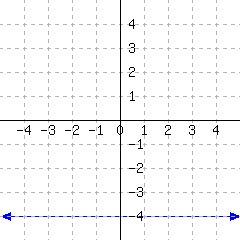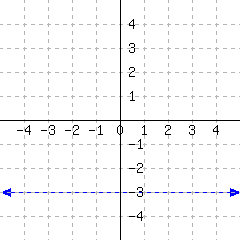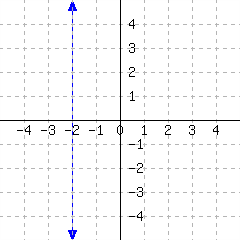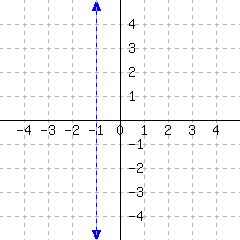Section 4.8 Horizontal, Vertical, Parallel, and Perpendicular Lines
Horizontal and vertical lines have some special features worth our attention. Also if a pair of lines are parallel or perpendicular to each other, we have some interesting things to say about them. This section looks at these geometric features that lines may have.
Subsection 4.8.1 Horizontal Lines and Vertical Lines
We learned in Section 4.7 that all lines can be written in standard form. When either \(A\) or \(B\) equal \(0\text{,}\) we end up with a horizontal or vertical line, as we will soon see. Let's take the standard form line equation, let \(A=0\) and \(B=0\) one at a time, and simplify each equation.
At the end we just renamed the constant numbers \(\frac{C}{B}\) and \(\frac{C}{A}\) to \(k\) and \(h\) because of tradition. What is important, is that you view \(h\) and \(k\) (as well as \(A\text{,}\) \(B\text{,}\) and \(C\)) as constants: numbers that have some specific value and don't change in the context of one problem.
Think about just one of these last equations: \(y=k\text{.}\) It says that the \(y\)-value is the same no matter where you are on the line. If you wanted to plot points on this line, you are free to move far to the left or far to the right on the \(x\)-axis, but then you always move up (or down) to make the \(y\)-value equal \(k\text{.}\) What does such a line look like?
Example 4.8.5.
Let's plot the line with equation \(y=3\text{.}\) (Note that this is the same as \(0x+1y=3\text{.}\))
To plot some points, it doesn't matter what \(x\)-values we use. All that matters is that \(y\) is always \(3\text{.}\)
A line like this is horizontal, parallel to the horizontal axis. All lines with an equation in the form
(or, in standard form, \(0x+By=C\)) are horizontal.
Example 4.8.7.
Let's plot the line with equation \(x=5\text{.}\) (Note that this is the same as \(1x+0y=5\text{.}\))
The line has \(x=5\text{,}\) so to plot points, we are required to move over to \(x=5\text{.}\) From there, we have complete freedom to move however far we like up or down.
A line like this is vertical, parallel to the vertical axis. All lines with an equation in the form
(or, in standard form, \(Ax+0y=C\)) are vertical.
Example 4.8.9. Zero Slope.
In Checkpoint 4.4.16, we learned that a horizontal line's slope is \(0\text{,}\) . So the numerator in the slope formula is \(0\text{.}\) Now, if we know a line's slope and its \(y\)-intercept, we can use slope-intercept form to write its equation:
This provides us with an alternative way to think about equations of horizontal lines. They have a certain \(y\)-intercept \((0,b)\) and they have slope \(0\text{.}\)
We use horizontal lines to model scenarios where there is no change in \(y\)-values, like when Kato stopped for \(12\) hours (he deserved a rest)!
Checkpoint 4.8.10. Plotting Points.
Example 4.8.11. Undefined Slope.
What is the slope of a vertical line? Figure 4.8.12 shows three lines passing through the origin, each steeper than the last. In each graph, you can see a slope triangle that uses a “rise” of \(4\) each time.
If we continued making the line steeper and steeper until it was vertical, the slope triangle would still have a “rise” of \(4\text{,}\) but the “run” would become smaller and smaller, closer to \(0\text{.}\) And then the slope would be \(m=\frac{4}{\text{very small}}=\text{very large}\text{.}\) So the slope of a vertical line can be thought of as “infinitely large.”
If we actually try to compute the slope using the slope triangle when the run is \(0\text{,}\) we would have \(\frac{4}{0}\text{,}\) which is undefined. So we also say that the slope of a vertical line is undefined. Some people say that a vertical line has no slope.
Remark 4.8.13.
Be careful not to mix up “no slope” (which means “its slope is undefined” ) with “has slope \(0\text{.}\)” If a line has slope \(0\text{,}\) it does have a slope.
Checkpoint 4.8.14. Plotting Points.
Example 4.8.15.
Let \(x\) represent the price of a new \(60\)-inch television at Target on Black Friday (which was \(\$650\)), and let \(y\) be the number of hours you will watch something on this TV over its lifetime. What is the relationship between \(x\) and \(y\text{?}\)
Well, there is no getting around the fact that \(x=650\text{.}\) As for \(y\text{,}\) without any extra information about your viewing habits, it could theoretically be as low as \(0\) or it could be anything larger than that. If we graph this scenario, we have to graph the equation \(x=650\text{,}\) which we now know to give a vertical line, and we get Figure 4.8.16.
Summary of Horizontal and Vertical Line Equations.
| Horizontal Lines | Vertical Lines |
|
A line is horizontal if and only if its equation can be written
\begin{equation*}
y=k
\end{equation*}
for some constant \(k\text{.}\) |
A line is vertical if and only if its equation can be written
\begin{equation*}
x=h
\end{equation*}
for some constant \(h\text{.}\) |
|
In standard form, any line with equation
\begin{equation*}
0x+By=C
\end{equation*}
is horizontal. |
In standard form, any line with equation
\begin{equation*}
Ax+0y=C
\end{equation*}
is vertical. |
If the line with equation \(y=k\) is horizontal, it has a \(y\)-intercept at \((0,k)\) and has slope \(0\text{.}\) |
If the line with equation \(x=h\) is vertical, it has an \(x\)-intercept at \((h,0)\) and its slope is undefined. Some say it has no slope, and some say the slope is infinitely large. |
|
In slope-intercept form, any line with equation
\begin{equation*}
y=0x+b
\end{equation*}
is horizontal. |
It's impossible to write the equation of a vertical line in slope-intercept form, because vertical lines do not have a defined slope. |
Subsection 4.8.2 Parallel Lines
Example 4.8.17.
Two trees were planted in the same year, and their growth over time is modeled by the two lines in Figure 4.8.18. Use linear equations to model each tree's growth, and interpret their meanings in this context.
We can see Tree 1's equation is \(y=\frac{2}{3}x+2\text{,}\) and Tree 2's equation is \(y=\frac{2}{3}x+5\text{.}\) Tree 1 was \(2\) feet tall when it was planted, and Tree 2 was \(5\) feet tall when it was planted. Both trees have been growing at the same rate, \(\frac{2}{3}\) feet per year, or \(2\) feet every \(3\) years.
An important observation right now is that those two lines are parallel. Why? For lines with positive slopes, the bigger a line's slope, the steeper the line is slanted. As a result, if two lines have the same slope, they are slanted at the same angle, thus they are parallel.
Fact 4.8.19.
Any two vertical lines are parallel to each other. For two non-vertical lines, they are parallel if and only if they have the same slope.
Checkpoint 4.8.20.
Checkpoint 4.8.21.
Subsection 4.8.3 Perpendicular Lines
The slopes of two perpendicular lines have a special relationship too.
Figure 4.8.22 walks you through an explanation of this realationship.
The second line in Figure 4.8.22 has slope
Fact 4.8.23.
A vertical line and a horizontal line are perpendicular. For lines that are neither vertical nor horizontal, they are perpendicular if and only if the slope of one is the negative reciprocal of the slope of the other. That is, if one has slope \(m\text{,}\) the other has slope \(-\frac{1}{m}\text{.}\)
Another way to say this is that the product of the slopes of two perpendicular lines is \(-1\) (assuming both of the lines have a slope in the first place).
Not convinced? Here are three pairs of perpendicular lines where we can see if the pattern holds.
Example 4.8.27.
Line \(A\) passes through \((-2,10)\) and \((3,-10)\text{.}\) Line \(B\) passes through \((-4,-4)\) and \((8,-1)\text{.}\) Determine whether these two lines are parallel, perpendicular, or neither.
We will use the slope formula to find both lines' slopes:
Their slopes are not the same, so those two lines are not parallel.
The product of their slopes is \((-4)\cdot\frac{1}{4}=-1\text{,}\text{,}\) which means the two lines are perpendicular.
Checkpoint 4.8.28.
Exercises 4.8.4 Exercises
Review and Warmup
1.
Evaluate the following expressions. If the answer is undefined, you may answer with DNE (meaning “does not exist”).
\(\displaystyle{ \frac{0}{2} = }\)
\(\displaystyle{ \frac{2}{0} = }\)
2.
Evaluate the following expressions. If the answer is undefined, you may answer with DNE (meaning “does not exist”).
\(\displaystyle{ \frac{3}{0} = }\)
\(\displaystyle{ \frac{0}{3} = }\)
3.
A line passes through the points \((4,-4)\) and \((-5,-4)\text{.}\) Find this line’s slope.
4.
A line passes through the points \((2,-1)\) and \((-3,-1)\text{.}\) Find this line’s slope.
5.
A line passes through the points \((1,-1)\) and \((1,5)\text{.}\) Find this line’s slope.
6.
A line passes through the points \((3,-3)\) and \((3,3)\text{.}\) Find this line’s slope.
7.
Consider the equation:
Which of the following ordered pairs are solutions to the given equation? There may be more than one correct answer.
\(\displaystyle (1,3)\)
\(\displaystyle (-9,1)\)
\(\displaystyle (8,1)\)
\(\displaystyle (0,10)\)
8.
Consider the equation:
Which of the following ordered pairs are solutions to the given equation? There may be more than one correct answer.
\(\displaystyle (-2,1)\)
\(\displaystyle (1,6)\)
\(\displaystyle (9,1)\)
\(\displaystyle (0,7)\)
9.
Consider the equation:
Which of the following ordered pairs are solutions to the given equation? There may be more than one correct answer.
\(\displaystyle (1,-1)\)
\(\displaystyle (0,-7)\)
\(\displaystyle (-1,0)\)
\(\displaystyle (-1,5)\)
10.
Consider the equation:
Which of the following ordered pairs are solutions to the given equation? There may be more than one correct answer.
\(\displaystyle (-1,1)\)
\(\displaystyle (-1,0)\)
\(\displaystyle (0,-9)\)
\(\displaystyle (1,-1)\)
Tables for Horizontal and Vertical Lines
11.
Fill out this table for the equation \(y=3\text{.}\) The first row is an example.
| \(x\) | \(y\) | Points |
| \(-3\) | \(3\) | \(\left(-3,3\right)\) |
| \(-2\) | ||
| \(-1\) | ||
| \(0\) | ||
| \(1\) | ||
| \(2\) |
12.
Fill out this table for the equation \(y=4\text{.}\) The first row is an example.
| \(x\) | \(y\) | Points |
| \(-3\) | \(4\) | \(\left(-3,4\right)\) |
| \(-2\) | ||
| \(-1\) | ||
| \(0\) | ||
| \(1\) | ||
| \(2\) |
13.
Fill out this table for the equation \(x=-6\text{.}\) The first row is an example.
| \(x\) | \(y\) | Points |
| \(-6\) | \(-3\) | \(\left(-6,-3\right)\) |
| \(-2\) | ||
| \(-1\) | ||
| \(0\) | ||
| \(1\) | ||
| \(2\) |
14.
Fill out this table for the equation \(x=-5\text{.}\) The first row is an example.
| \(x\) | \(y\) | Points |
| \(-5\) | \(-3\) | \(\left(-5,-3\right)\) |
| \(-2\) | ||
| \(-1\) | ||
| \(0\) | ||
| \(1\) | ||
| \(2\) |
Line Equations
15.
A line passes through the points \((-1,3)\) and \((-4,3)\text{.}\) Find an equation for this line.
16.
A line passes through the points \((-4,6)\) and \((1,6)\text{.}\) Find an equation for this line.
17.
A line passes through the points \((8,3)\) and \((8,5)\text{.}\) Find an equation for this line.
18.
A line passes through the points \((10,-1)\) and \((10,-4)\text{.}\) Find an equation for this line.
19.
A line’s graph is shown. Write an equation for the line.

20.
A line’s graph is shown. Write an equation for the line.

21.
A line’s graph is shown. Write an equation for the line.

22.
A line’s graph is shown. Write an equation for the line.

Intercepts
23.
Find the \(y\)-intercept and \(x\)-intercept of the line given by the equation. If a particular intercept does not exist, enter none into all the answer blanks for that row.
| \(x\)-value | \(y\)-value | Location | |
| \(y\)-intercept | |||
| \(x\)-intercept |
24.
Find the \(y\)-intercept and \(x\)-intercept of the line given by the equation. If a particular intercept does not exist, enter none into all the answer blanks for that row.
| \(x\)-value | \(y\)-value | Location | |
| \(y\)-intercept | |||
| \(x\)-intercept |
25.
Find the \(y\)-intercept and \(x\)-intercept of the line given by the equation. If a particular intercept does not exist, enter none into all the answer blanks for that row.
| \(x\)-value | \(y\)-value | Location | |
| \(y\)-intercept | |||
| \(x\)-intercept |
26.
Find the \(y\)-intercept and \(x\)-intercept of the line given by the equation. If a particular intercept does not exist, enter none into all the answer blanks for that row.
| \(x\)-value | \(y\)-value | Location | |
| \(y\)-intercept | |||
| \(x\)-intercept |
Graphs of Horizontal and Vertical Lines
27.
Graph the line \(y=1\text{.}\)
28.
Graph the line \(y+5=0\text{.}\)
29.
Graph the line \(y-6=0\text{.}\)
30.
Graph the line \(x=2\text{.}\)
31.
Graph the line \(x+4=0\text{.}\)
32.
Graph the line \(x-3=0\text{.}\)
Parallel or Perpendicular?
33.
Line \(m\) passes points \((-4,-25)\) and \((1,0)\text{.}\)
Line \(n\) passes points \((1,-4)\) and \((5,16)\text{.}\)
These two lines are
parallel
perpendicular
neither parallel nor perpendicular
34.
Line \(m\) passes points \((-9,4)\) and \((-27,8)\text{.}\)
Line \(n\) passes points \((9,-11)\) and \((-18,-5)\text{.}\)
These two linea are
parallel
perpendicular
neither parallel nor perpendicular
35.
Line \(m\) passes points \((6,-1)\) and \((-6,5)\text{.}\)
Line \(n\) passes points \((1,-8)\) and \((2,-6)\text{.}\)
These two lines are
parallel
perpendicular
neither parallel nor perpendicular
36.
Line \(m\) passes points \((6,-10)\) and \((-9,10)\text{.}\)
Line \(n\) passes points \((8,-3)\) and \((-8,-15)\text{.}\)
These two lines are
parallel
perpendicular
neither parallel nor perpendicular
37.
Line \(m\) passes points \((4,-4)\) and \((-5,23)\text{.}\)
Line \(n\) passes points \((1,10)\) and \((-3,-2)\text{.}\)
These two lines are
parallel
perpendicular
neither parallel nor perpendicular
38.
Line \(m\) passes points \((1,1)\) and \((-5,1)\text{.}\)
Line \(n\) passes points \((10,-5)\) and \((-9,-5)\text{.}\)
These two lines are
parallel
perpendicular
neither parallel nor perpendicular
39.
Line \(m\) passes points \((3,-6)\) and \((3,3)\text{.}\)
Line \(n\) passes points \((10,10)\) and \((10,1)\text{.}\)
These two lines are
parallel
perpendicular
neither parallel nor perpendicular
40.
Line \(m\) passes points \((5,7)\) and \((5,-9)\text{.}\)
Line \(n\) passes points \((4,10)\) and \((4,-10)\text{.}\)
These two lines are
parallel
perpendicular
neither parallel nor perpendicular
Parallel and Perpendicular Line Equations
41.
A line passes through the point \((-2,0)\text{,}\) and it’s parallel to the line \(y=8\text{.}\) Find an equation for this line.
42.
A line passes through the point \((9,-7)\text{,}\) and it’s parallel to the line \(y=10\text{.}\) Find an equation for this line.
43.
A line passes through the point \((6,-4)\text{,}\) and it’s parallel to the line \(x=-9\text{.}\) Find an equation for this line.
44.
A line passes through the point \((-1,5)\text{,}\) and it’s parallel to the line \(x=-6\text{.}\) Find an equation for this line.
45.
Line \(k\) and Line \(\ell\) are parallel.
Line \(k\) has equation \(y=3x+3\text{.}\)
Line \(\ell\) passes through the point \((-5,-11)\text{.}\)
Find an equation for Line \(\ell\) both in point-slope form and slope-intercept form.
Line \(\ell\) in point-slope form is
Line \(\ell\) in slope-intercept form is
46.
Line \(k\) and Line \(\ell\) are parallel.
Line \(k\) has the equation \(y=4x+5\text{.}\)
Line \(\ell\) passes through the point \((4,15)\text{.}\)
Find an equation for Line \(\ell\) both in point-slope form and slope-intercept form.
Line \(\ell\) in point-slope form is
Line \(\ell\) in slope-intercept form is
47.
Line \(k\) and Line \(\ell\) are parallel.
Line \(k\) has the equation \(y=-\frac{1}{3}x+8\text{.}\)
Line \(\ell\) passes through the point \((-9,7)\text{.}\)
Find an equation for Line \(\ell\) both in point-slope form and slope-intercept form.
Line \(\ell\) in point-slope form is
Line \(\ell\) in slope-intercept form is
48.
Line \(k\) and Line \(\ell\) are parallel.
Line \(k\) has the equation \(y=-\frac{2}{7}x-7\text{.}\)
Line \(\ell\) passes through the point \((14,1)\text{.}\)
Find an equation for Line \(\ell\) both in point-slope form and slope-intercept form.
Line \(\ell\) in point-slope form is
Line \(\ell\) in slope-intercept form is
49.
Line \(k\) and Line \(\ell\) are perpendicular.
Line \(k\) has the equation \(y=-x+5\text{.}\)
Line \(\ell\) passes through the point \((-3,1)\text{.}\)
Find an equation for Line \(\ell\) both in point-slope form and slope-intercept form.
Line \(\ell\) in point-slope form is
Line \(\ell\) in slope-intercept form is
50.
Line \(k\) and Line \(\ell\) are perpendicular.
Line \(k\) has the equation \(y=-3x-4\text{.}\)
Line \(\ell\) passes through the point \(\left(2,-\frac{7}{3}\right)\text{.}\)
Find an equation for Line \(\ell\) both in point-slope form and slope-intercept form.
Line \(\ell\) in point-slope form is
Line \(\ell\) in slope-intercept form is
51.
Line \(k\) and Line \(\ell\) are perpendicular.
Line \(k\) has the equation \(y=\frac{5}{8}x+5\text{.}\)
Line \(\ell\) passes through the point \(\left(-2,\frac{36}{5}\right)\text{.}\)
Find an equation for Line \(\ell\) both in point-slope form and slope-intercept form.
Line \(\ell\) in point-slope form is
Line \(\ell\) in slope-intercept form is
52.
Line \(k\) and Line \(\ell\) are perpendicular.
Line \(k\) has the equation \(x-5y=-25\text{.}\)
Line \(\ell\) passes through the point \((3,-13)\text{.}\)
Find an equation for Line \(\ell\) both in point-slope form and slope-intercept form.
Line \(\ell\) in point-slope form is
Line \(\ell\) in slope-intercept form is
Challenge
53.
Prove that a triangle with vertices at the points \((1, 1)\text{,}\) \((-4, 4)\text{,}\) and \((-3, 0)\) is a right triangle.
